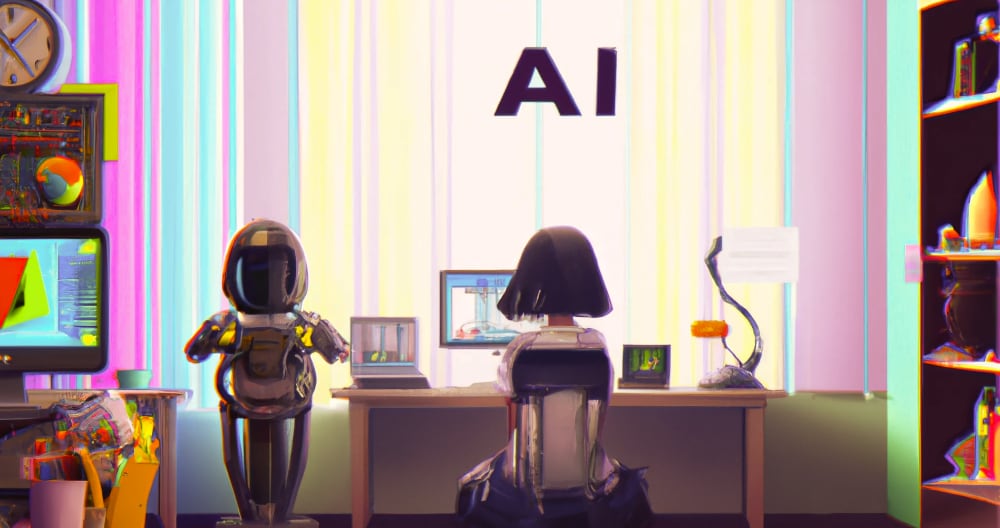Growing ChatGPT AI Generated Content Everywhere, Should We Be Fearful?

The trending articles that burst out on my news reader surround the use of ChatGPT AI or Open AI-generated content. Most articles discuss and warn of the danger of widely used AI-generated content, including images, in academic essays, and many more. Only a couple of the pieces examine the positive aspects of ChatGPT AI.
Should we be fearful of the rise of AI bots? Most of us have watched shows like “Terminator” and the like. When the storyline seemingly creeps up to our reality, the idea of artificial intelligence rapidly replacing us invokes the very crisis of our existence. But are things going to go that way?
To understand all the hype about ChatGPT AI, I dived into the pool of AI bot platforms. I posted an article, “How To Spot A Manipulative Partner Early And Avoid Incompatible Relationships?” using partially AI-generated content. I determined the structure and key discussion points of the article. I added sections on personal experiences and richened conclusions, but at least 50% of the contents are AI-generated based on my tweaking and fine-tuning.

Initially, I had meant to write a post inspired by my personal experience with a guy I dated in my 20s. It prompted me to consider the gender role differences and the wrong questions we have been asking ourselves when we seek a life partner. We often end up with incompatible partners, and with the lack of introspection and mindfulness, we continue to repeat the pattern that brings us heartbreaks.
Before I started typing out my thoughts, my husband and I engaged in a deep discussion about ChatGPT AI and evaluated the advantages and disadvantages of pushing AI bots into the mainstream of usage. So, I decided to conduct an informal experiment to use an AI bot to help me write part of my article. I did not think it would be that great; after all, my outdated impression of AI bots parked at the consumer product level – chat support – and I have not been that impressed thus far.
My First Impressions On AI Generators
With a “try and see” attitude, I tried my hands on the AI generators, and I was blown away! My immediate reactions were excitement and awe! My following quick response was to see how the generators could improve my writing and creativity! My hyperactive mind bursts out a million thoughts and ideas, and I found myself generating an image fitting my article. The “How To Spot A Manipulative Partner Early And Avoid Incompatible Relationships?” image is AI-generated. I sensed my adrenaline rush and yelled to my husband to share the excitement with me while I rattled madly about how impressed I was with the image, as it was nearly as close to what I imagined in my mind. I draw some, but I definitely do not have the skills to create an image of the same quality. The image illustrates the relationship toxicity between the two people, yet, they continue to breathe the poisoned air through the shared masks.
Instead of being afraid that artists will soon be replaced, consider how many people who are not artistically talented could benefit from having the AI bot fulfill their dreams of creating something. We may always still have a special place for talented artists, but perhaps they could now become strict critics of AI-generated artwork.
My Position on AI Generators
The image used in this article shows the girl on her computer and a bot by her desk. The image illustrates the friendliness between the bot and the girl. Generally, I am pro-tech; I am conservatively pro-AI. I would embrace AI generators more fully when we have balanced regulations that promote the development of AI to support and not replace humans; to relieve humans of their overly expanded cognitive and physical capacities, and not to compete with humans in capabilities to work non-stop.
ChatGPT AI Impacts On Education System And Models
The Teachers
Sadly, in recent decades, teachers’ most common complaints have been underpaid salaries and overworked environments. We would think that technological advancements should help relieve the teachers’ workload, but we often exploit the tech to “punish” humans. I would think that the time saved from traditional manual tasks, such as writing or drawing by hand, should be paid towards teachers’ restfulness by reducing the previously needed extra hours. Instead, we consider the unpaid extra hours as the new regular hours and pack the timetable as though teachers do not deserve rest.
The Students
I have never been a teacher, but I have friends who were previously one or still struggling as one. However, I have been a recurring student for various specializations – I am inquisitive! My latest role as a full-time University student was a few years ago, pursuing a bachelor’s degree in psychology. I experienced a leap from a partially tech-supported learning environment to a heavily tech-supported learning style. I could download recorded lectures, submit assignments online, and even take some examinations online! Instead of heavy binders containing published studies as study materials, I just needed to log on to the student portal and download all the materials in PDF format.
I loved and appreciated the pro-tech learning setting, but as always, we falsely assume that humans’ capacity can expand exponentially. In my second semester, the university changed the course credit structure. Instead of four credit points per module, we earned three credit points per module. The school attempted to convince us that contact time was reduced with the credit points adjustment; however, we would need to enroll in additional modules for each semester. Contact time meant the time we spent with the teachers or teaching assistants. While that was true, the work was not reduced. They expected students to expand self-study time and teachers to work extra hours attending to in-demand queries and marking assignments.
In appearance, the teachers were not in class with the students more than they needed to be since most communications were electronically transmitted. Students were not seen in classes but expected to self-teach on materials that the shortened in-class teaching ran short. Self-teaching meant many questions for the teachers, and teachers would work more unpaid hours.
Students from pre-tech times would spend many hours reading or making copies of publications and recommended readings in the library. I enjoyed the convenience of a technologically enhanced library and just needed to click on my keyboard to download, and I had the readings in the comfort of my home. The convenience comes with a cost. The required and recommended readings expanded to more than any non-genius level student could absorb and process, and often, we did not have enough time to finish reading even the required readings.
Changes Are Needed
Teachers have complicated feelings about the rise of AI-generated content used by students to write their essays and assignments. They question if students can develop critical thinking and creativity if they can use AI bots to help them write their essays. Perhaps we are asking the wrong questions. Maybe, we should change how we teach because the new generation is exposed to information dramatically differently from the previous generation, and we should consider eliminating and modifying teaching methods.
If the bots are writing better essays, perhaps we do not need the students to write essays on their own anymore. We can still assess their understanding of the topic through an interactive learning format that tests not just memory but spontaneous responses and shared learning.
A Little Story About My Big Sister
The insistence on making a specific component more important than others in education fails our children. I do not know for sure, but I am confident that my sister could have soared much higher in her academic journey if language proficiency had been less critical than it was. My sister fared exceptionally well in all subjects, especially in Sciences and Mathematics, but she tested poorly in English and Chinese, the first and second languages. I vividly remember that she won the first prize in an inter-school mathematic competition; I received a consolation prize for participating. The lack of interest and talent in language comprehension stunted her academic and personal growth.
Suppose she did not need to write essays in a structurally accurate manner, but she could read scientific studies and mathematically complicated equations just as well. In that case, she could be a scientist, a mathematician, an engineer, or anything she wanted in the areas she loved. Don’t get me wrong; she gained success in other ways; I am saying she could have had more options and opportunities.
I Could Not Have Come This Far Without Tech Improvements
I was born and bred in Singapore. As a mature adult, I moved to Australia to pursue my passion for studying psychology and to Denmark for a year in an exchange program. I have a condition known as dyscalculia, commonly referred to as math disorder, so the numeric module in my cognitive functions is limited and affects my numerical reasoning. Dyscalculia affects people differently, and my most pronounced impediments are spatial reasoning and faint cognitive impressions of numbers. Plainly, I get lost easily because I have a poor 3D rotation in my mind, so my mind cannot understand that the path in the front view can be the same path in the side view. Mathematically, I am exceptional in concept comprehension but not calculations. It is a little tricky to explain because it is frequently misunderstood that dyscalculia affects both conceptual and mathematical reasoning. Conceptual understanding depends greatly on logical construction and reason, so it contains pattern recognition, whereas mathematical reasoning requires memory retention of numbers. In my case, it is more challenging to retain the memory of numbers because the numbers have little meaning to me (not by choice); therefore, it is harder to anchor a memory retrieval cue for later extraction.
Although I did not venture around Australia and Denmark as much as my fellow international coursemates, it would not have been possible for me to survive living abroad independently if not for technological improvements and accessibilities. I used Google Maps and Google Translate a lot to get around places in Australia and Denmark. I instantly translated labels and signs from Dansk to English while shopping or reading instructions to operate the washer in the communal laundry room. These are just some examples that helped me cope with the basic tasks.
I Have Faith In Humans’ Fears
Ideally, technology development should be focused on supporting and supplementing humans. No one person I now know does not complain about overworking and having trouble focusing on tasks. Everyone is overworked to the point of mental and physical exhaustion. If we made machines and robots, they should help us take on the tasks humans no longer want to do and yet not penalize humans for using them. Make machines work for humans, not humans serving the machines.
I watched a poignant video showing a farming family whereby the parents worked so hard in the fields, and the son decided to build semi-automated machines to help the parents with the physically demanding work such as plowing and seeding. It was heartwarming to watch because the parents had more time to rest under the shade and play with their grandchildren.
It is hard to see such a model implemented in industrialized operations because employers are not the employees’ parents. It is up to the regulators to impose policies to ensure the welfare of people is protected. In some countries, companies are incentivized with government grants to push for new tech while securing the current workforce.
I begin this section with “Ideally” because we may be unable to materialize idealism. However, I have faith in humans’ fears. Fear is a powerful driver of self-preservation. It is a positive driver when balanced against the need for progression. If not for our fears, the tech advancement would have far exceeded today’s mark. In conclusion, based on human history, we present strong pattern indications that we will put self-preservation and self-interest before most greater good. So, I am not too worried about the bots replacing us; fear will prevail.
(This article is human-generated, except for the featured image, which is AI-generated.)
- Growing ChatGPT AI Generated Content Everywhere, Should We Be Fearful? - January 14, 2023
- How To Spot A Manipulative Partner Early And Avoid Incompatible Relationships? - January 8, 2023
- Sustaining Admiration Leads to Lasting Love - May 5, 2022
